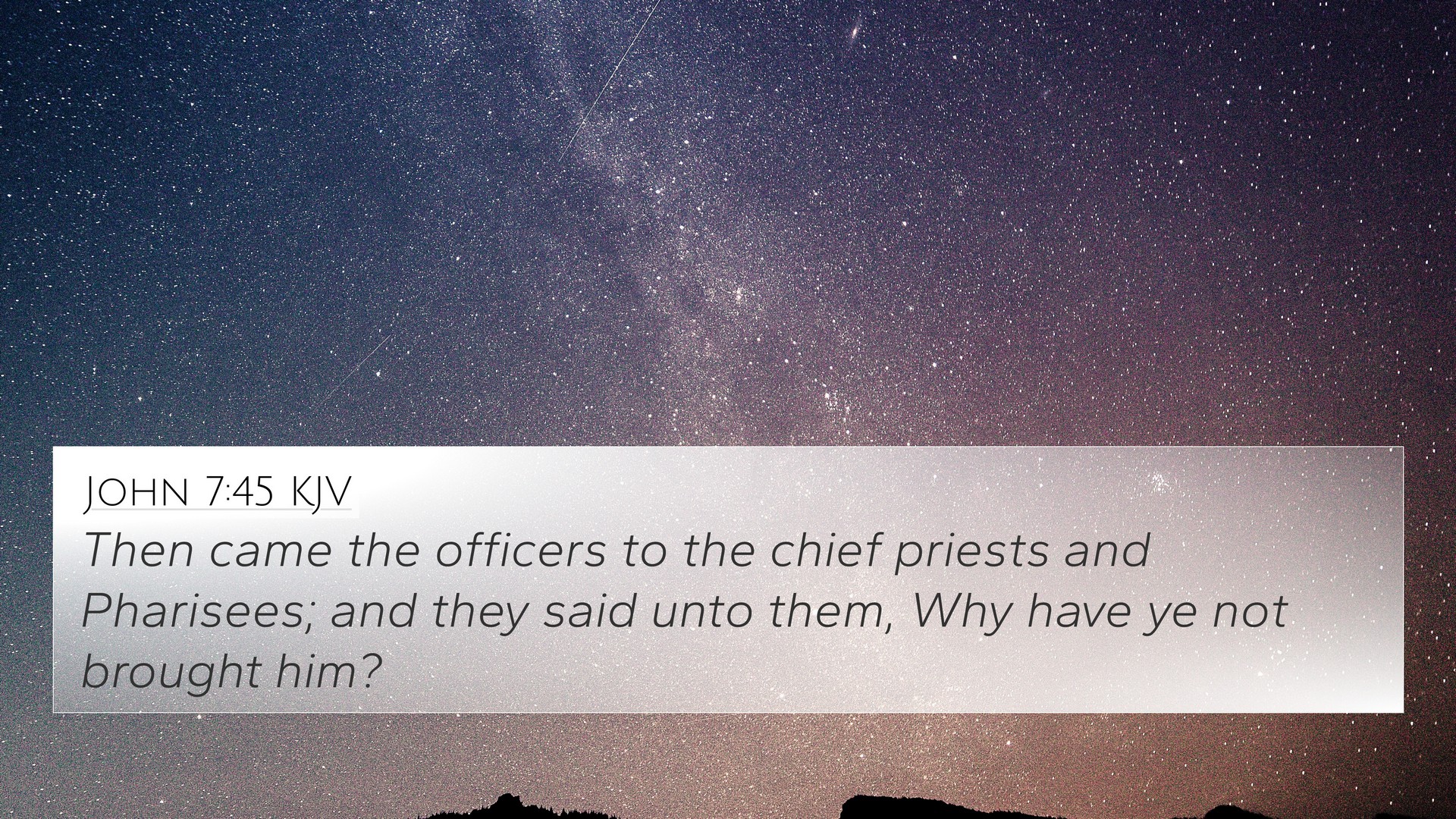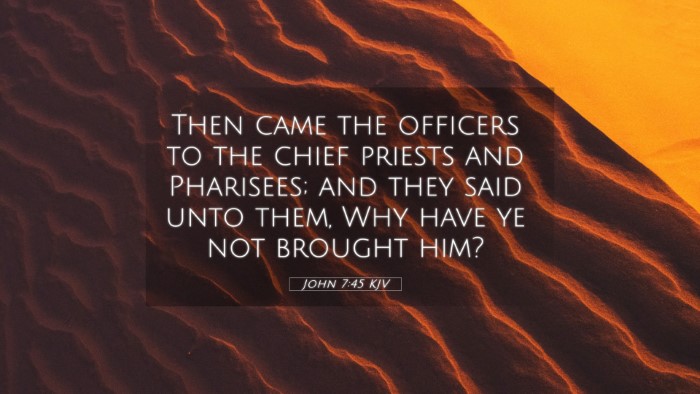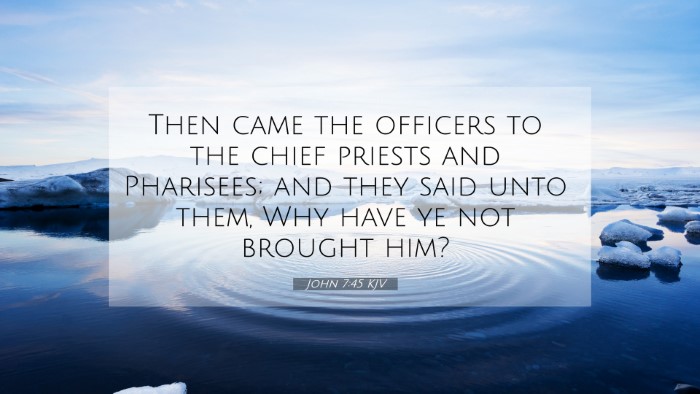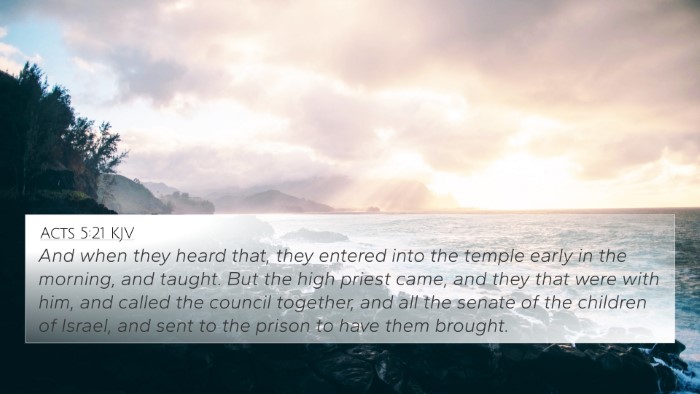Understanding John 7:45
John 7:45 states, "Then came the officers to the chief priests and Pharisees; and they said unto them, Why have ye not brought him?" This verse captures a moment where the religious authorities of the time questioned the officers sent to arrest Jesus, highlighting the tension between Jesus and the Jewish leaders.
Verse Summary and Context
In the context of John 7, Jesus is teaching in the temple during the Feast of Tabernacles. He is making bold claims about His identity and His teaching, which has stirred controversy. The chief priests and Pharisees send officers to arrest Him but upon witnessing His teaching, the officers return without Him. This raises questions about their loyalty and authority.
Insights from Commentaries
-
Matthew Henry:
Henry emphasizes the irony in the situation; the officers were to enforce the law yet found themselves unable to proceed against a man whose words astonished them. This illustrates the profound impact Jesus had on all who encountered Him.
-
Albert Barnes:
Barnes notes that the officers' return without Jesus indicates an internal conflict regarding their duties. He highlights how Jesus’ authority superseded that of the religious leaders, which is pivotal in understanding the lack of action from the officers.
-
Adam Clarke:
Clarke discusses the significance of the officers' return, suggesting that their experience challenged their preconceived notions of authority and obedience. They were witnesses to a greater truth that rendered their mission impossible in light of Jesus’ arguments.
Bible Cross-References
To better understand John 7:45, here are several significant cross-references that highlight its themes and connections:
- John 7:12 - "And there was much murmuring among the people concerning him..." - Illustrates the growing divide in public perception of Jesus.
- John 7:40 - "Many of the people therefore, when they heard this saying, said, Of a truth this is the Prophet." - Reflects varying opinions about Jesus’ identity.
- Luke 20:20 - "And they watched him, and sent forth spies, which should feign themselves just men..." - Shows the Pharisees’ ongoing attempts to entrap Jesus.
- Matthew 22:46 - "And no man was able to answer him a word..." - Similarities in the authority of Jesus' discourse which silenced His critics.
- John 7:32 - "The Pharisees heard that the people murmured such things concerning him..." - Indicates the Pharisees’ concern about Jesus’ influence.
- John 8:12 - "I am the light of the world..." - Further exploration of Jesus’ identity and mission.
- John 10:18 - "No man taketh it from me, but I lay it down of myself..." - Emphasizes Jesus’ voluntary submission to authority.
- Acts 7:51 - "Ye stiffnecked and uncircumcised in heart and ears..." - A reflection on the hardness of the hearts of the religious leaders since the time of Jesus.
- 1 Corinthians 1:18 - "For the preaching of the cross is to them that perish foolishness..." - Touches on different responses to Jesus’ message.
- Hebrews 7:14 - "For it is evident that our Lord sprang out of Judah..." - Reinforces Jesus’ royal lineage and authority.
Connections Between Scriptures
The discourse in John 7:45 offers rich opportunities for thematic connections between the Old and New Testament, highlighting the continuity of God’s revelation and mankind's response. Understanding these connections can enhance one's study through cross-referencing Biblical texts, as explored in the following themes:
-
Authority and Obedience: John 7:45 demonstrates the challenge of authority; compare with Exodus 20:12 regarding authority to honor parents, or Romans 13:1 on submission to governing authorities.
-
Context of Message: The contextual backdrop of the Feast of Tabernacles (Leviticus 23:39-43) relates significantly to the evaluation of Jesus’ identity and mission.
-
Perception of Jesus: As shown in John 7:12, perceptions about Jesus vary, similar to the debates in Matthew 16:13-14 where Christ’s identity was questioned.
-
Impact of Teaching: The officers’ return points to their experience of powerful teaching evident in Matthew 7:28-29, showcasing the authority of Jesus’ words.
-
Conflict with Religious Leaders: Similar to the conflict seen in Jeremiah 20:10-11 regarding the messenger of God, highlighting the recurring theme in Scripture of God’s prophets facing hostility.
Tools for Bible Cross-Referencing
To deepen the understanding of John 7:45 and its connections, one may employ various tools for Bible cross-referencing. These include:
- Bible Concordance: A helpful resource for locating keywords and finding passages that connect through themes or topics.
- Bible Cross-Reference Guide: Specific guides can lead you to verses that interlink with each other contextually.
- Cross-Reference Bible Study: Engaging in structured Bible study focusing on linked verses to gather comprehensive understandings.
- Cross-Referencing Bible Study Methods: Methods such as thematic analysis or genealogical charts can illustrate inter-Biblical dialogues.
Conclusion
John 7:45 serves as a poignant reminder of the challenges faced by those who interacted with Jesus and the weight of His teachings. Its connections to other scripture verses and the insights provided by commentaries reveal much about authority, identity, and the nature of obedience. Through careful study and the use of cross-referencing tools, one can glean deeper meanings and relationships that enrich one’s understanding of the Bible as a unified text.




